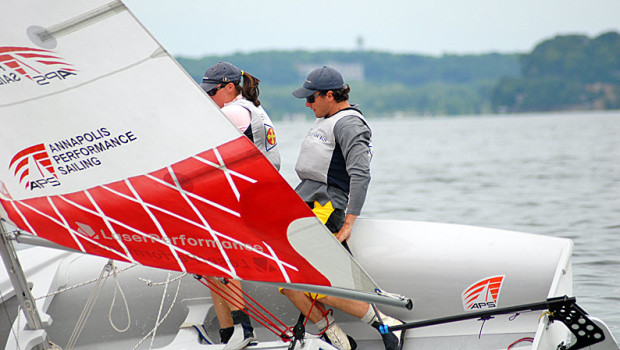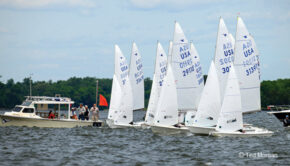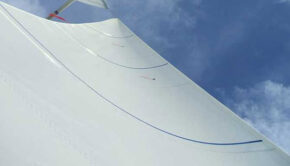High School to College Crewing Guide
Published on October 14th, 2013
By Brooke F. Thomson, St. Mary’s College of Maryland
In high school, I remember someone asking a college crew if sailing ever got boring because she had already accomplished so much in high school and junior sailing. She answered, “Well, no matter how good of a crew you are, college sailing just makes you better.”
In my opinion, high school sailing teaches crews most of the skills they need to know, but college sailing fine-tunes and expands on those things. College crews come from a huge range of experience levels and backgrounds, but what they have in common is that everyone makes changes along the way to adapt. This guide is an attempt to pinpoint some of the bigger reasons that contribute to this transition and list all the little details that go a long with it.
Some Thoughts on Boat-Handling
More than anything, it’s a matter of practice. Personally, I learned boat handling mostly by listening to skippers “input” and watching other crews. Everyone learns differently, but I’ve found the best help usually comes from the person you’re actually in the boat with.
Eventually it becomes a matter style and being able to mesh easily to new skippers and their style. Adaptability is one of the big things that separate a good crew from the average. For a crew at any level it’s an easy mistake to get stuck in a rut, but one of the biggest things I’ve learned from college sailing is that there’s always something that can be done slightly different for better or for worse. Sometimes a change can be as insignificant as using your left hand instead of the right, but those little things tend to open the door for bigger changes. In a way boat-handling style is sort of a creative process. The best way to perfect boat handling I think is to experiment and take risks.
A lot of the time if something feels off the best way to fix it is just ask your skipper to do a few tacks or jibes with you in a row, and focus on just fixing one thing at a time until it clicks. But basically, with repetition it eventually falls together. Just don’t over think it.
Some General Things:
1. From my west-coast perspective, college sailing takes place in smaller bodies of water than high school does. Flat water with shifty unpredictable wind blocked by buildings is common. This is true of a lot of venues like Boston University, Connecticut College, Tufts, and Coast Guard Academy.
This changes the game in that the crew has to be more aware of sailing smart and being flexible. It becomes important to be sensitive to “shifting-gears” and making smaller adjustments more frequently.
2. Courses are more standardized, so that each race is about 20 minutes long. Even if the time is off, a race committee will usually work really hard to make each leg and each race as standardized as possible. So if the wind picks up or dies, you know they have to lengthen or shorten the course to meet that requirement.
3. The range of talent in each fleet is a lot narrower. In high school it’s easier to see a difference between the first boat and the last boat to cross the finish line. But in a lot of college events, the fastest boat usually isn’t as noticeably different from the last boat. For a crew, this makes the little things count more.
a. Boat handling becomes more fine-tuned and consistent. Because there are more crews on the line with similar experience, a couple great tacks when the boats next to you do a few good tacks can launch you ahead. On the other hand, it’s easier to fall behind the fleet with just a few slip-ups.
b. Consistency from race to race makes a huge difference. It’s a lot more common to see boats that were doing well in the morning get tired at the end of the day, and consistent teams pull ahead.
4. A lot of fleet racing regattas don’t have 2 on/ 2 off rotations. Academies like Kings Point or Navy have 18 CFJ’s and 18 420’s, so they run A and B division at the same time.
a. Be ready for longer days without breaks. It’s worth it to bring a snack (and sometimes a snack for your skipper). For crews a common problem is that by being active all day, their metabolism shuts down so it’s uncomfortable to eat in between races. Especially to eat and then hike. I learned the hard way that it’s a lot easier to do small snacks through the day if you don’t do a real lunch.
b. A crew needs to be equally good with 420’s and FJ’s. Typically it’s easier to enjoy sailing in whichever boat your better at. I think a turning point for a lot of crews is when it doesn’t matter what boat they’re in.
5. Different venues mean different boats and sails. It took me a long time to feel the smaller differences among boats and longer to be comfortable with adjusting properly.
a. Always pay attention to the jib size and shape before you start racing.
b. Main shapes also vary depending on the make of the sail and how long they’ve been used. Look up to gauge if you need more outhaul/downhaul for a fuller or blown-out main.
c. A frequent mistake is not having enough outhaul on. Along that line, it’s also good to check the outhaul in the cleat to make sure it isn’t worn out.
d. If sailing 420’s, some places have filled-rails. This means that the boats are heavier and boat handling needs to be slower and more forceful.
6. Most crews in high school already sit backwards in FJs. This is even more prevalent with college crews. Sitting forward is fine if it’s what’s easier for the crew, but sitting backward typically makes weight placement better and helps position you better for boat handling.
7. Ooching is legal in surfing conditions downwind. Don’t ooch in a real high school race, but its worthwhile to practice.
8. It’s a lot more important to keep track of your bailer. In college you usually need to bail during races instead of in between. Most crews keep track of bailers and tie a thin line around the handle. On the other end of it is a stopper-knot small enough to slide under the main or jib halyard. This keeps the bailer safe in case you flip and prevents it from rolling around in the boat.
Some More Specific Things
On The Starting Line:
On the starting line the crew is expected to participate a lot more in boat set up, communication, and tactics. In high school I was often told that a bad start was mostly out of the crew’s hands, but in college I found that responsibility is much more shared.
1. Pre-Start: Take the initiative to rig and check over the boat and don’t wait for the skipper to say something. College regattas involve longer days and more rotations so it’s easy to start letting the little things slide.
2. When adjusting a lot of things (like jib halyard) the skipper can’t see what you’re doing. It helps to always narrate exactly how much your adjusting things.
3. Keep vang trimmed as if you’re on a reach on the line, then trim for upwind after the gun.
4. Be good at adjusting the jib halyard without the skipper’s help. The most common method is for the crew to put a foot against the mast by the vang and push it away while taking the slack out of the halyard. It helps a lot to be sailing on a reach or downwind with the jib full.
It also helps make the adjustment faster if the halyard is tied off right. Basically, it should be a really clean figure “8” with the slack end of the line should be facing towards you so it’s easier to pull.
5. Before or in the beginning of sequence spend a second with the skipper looking up the course. Know where the marks are, which side of the coarse and which side of the line is favored. Look for things like wind-shifts, current, anything particular to that race. Try to start thinking one step ahead of the race committee, for example, if you noticed a big wind shift expect the race committee to move marks.
6. Being verbal on the line is more important. Ideally, the skipper shouldn’t have to look behind the boat or below the jib to know what’s happening.
7. In the last 10 seconds or so, look both ways along the line to gauge if you’re over or under the line.
8. As you rock to leeward, be sure the timing is right. As you trim the jib, it’s really important to not trim it too fast. Let the front few inches of it luff just a bit until you’re fully headed upwind.
Trimming the jib too fast will make the bow want to head down, which would counter-act what the skipper’s trying to do with the main and bodyweight.
Upwind:
1. The first 45 seconds after the race are the most important. Managing attention between boat speed and tactics can sometimes be a little bit like rubbing your belly and tapping your head. In high school, it’s easier to get away with doing one thing at a time, but in college it’s more important to be able to do both at once.
2. Detailed vang trim makes a big difference. Up the course, every time there’s a puff or lull big enough where you have move in or out of the boat, it’s time to adjust the vang.
In a 420 with breeze, take the slack out and then another inch or two.
3. It’s worthwhile to be really good at ducking boats. Make sure to ease and trim in sync with the skipper in order to get that extra pump. Also, bodyweight placement makes a difference.
4. Keep the boat flat. You can use the line of the back of the boat and make it parallel to the line of the horizon, or at least so it doesn’t move much compared to the horizon. Sometimes this takes concentration, and also looking up the coarse to predict little puffs making and making little adjustments before it comes.
5. The course. Always be looking around for the wind and what the fleet is doing.
6. Bail! Bail whenever possible!
7. Call layline.
Tacks:
1. Try being really sensitive to everything a skipper does. A skipper shouldn’t have to tell the crew when they’re about to tack.
2. In general, try to remember that tacking is more about timing than force. The longer you back the jib the more the boat will want to roll, so don’t rush it.
3. As you come up to each rail take a moment to twist you’re body so that you’re rolling/flattening off your butt and not your hip. In the long run (even in really light air) it will give you a lot more power with less energy.
4. For 420 light air tacks, get both feet on the side of the centerboard you roll on and both feet across the boat for the flatten. If you’re having trouble rolling hard enough, try to get comfortable putting both feet on each side in an FJ too.
5. Trimming out of a tack, try to get the jib and main trimmed at the same time. Listen to the mainsheet ratchet, and try to get the amount of jib sheet trim to match it (in inches and timing).
Downwind:
1. Like upwind, the main goal is to keep the boat flat. If you think of it like a balance board, start to predict each little tiny movement and counter-act it before it happens. Once again, to begin the best way to gauge this is to watch the bow or stern of the boat and try to prevent it from moving.
2. Sitting versus standing. It’s tempting to relax on the centerboard trunk, but you constantly have to be moving. Start making smaller adjustments by using shoulders, and then bigger adjustments use entire body.
3. The crew should always be looking backwards.
4. If you’re having trouble with heel, use at the tiller as a gauge. Use your weight to make the tiller stay in place without the skipper holding it. Usually that place is slightly away from the skipper (roughly a 45 degree angle pointed away from the skipper).
5. When holding the jib out on a reach, hold onto the jib sheet that goes to the windward block. It’s natural to hold onto the line that feeds into the leeward ratchet (your side of the boat), but it’s easier to grab the other one (the one that sits in front of the mast). This makes it so you can keep the slack out of the leeward sheet and trim from the ratchet faster if you’re skipper needs to jibe or head up suddenly.
6. There’s a lot more adjusting the vang. Smaller adjustments more frequently are important.
a. The easiest way to think of vang trim is to consider it like adjusting a separate sail. Look behind you to anticipate puffs, and trim or ease the jib slightly to prepare. A lot of crews always have a hand on the vang downwind.
b. In breeze, de-power using vang, not centerboard (unless you’re about to flip). Look behind you to watch puffs coming your way and have the vang on before they reach your boat. Remember to take the vang off the second the puff passes.
c. Watch the twist at the top of the sail. Another way to tell is to look at end of the boom. In puffs, the boom should have some breathing space to come up a bit in puffs, but you don’t want it moving too much.
7. Bail!
Jibes:
1. Try to keep the jib full through the entire jibe. It may help to just keep your eyes on the jib and nothing else through the jibe.
2. If the skipper heads down but doesn’t jibe, and the jib wants to come over, hold the jib on a wing. This is also the same for approaching the leeward mark.
3. In light air + chop, take the slack out of the vang before jibing. This will help prevent the batten from inverting.
4. The first thing to do out of any jibe is to push the boom all the way out to the shroud. Also check to make sure the baton isn’t inverted.
5. In college I found more skippers preferred a really snappy transition out of a wing-to-wing jibe where the jib went straight to them, no matter what.
a. Before the jib fills, and as you stand up (pushing the boom out to the shroud) yank it over to the other side. It helps to imagine the hand going straight from the ratchet to the top of the mast. If you listen to the ratchet it should sound like one ripping noise, instead of hearing all of the individual clicks.
b. To make sure it works every time, it takes some maintenance between jibes. If there’s any slack in the jib sheets before a jibe, you’re arm won’t be long enough to get the jib full in one movement. Before jibing, take all the slack out on either ratchet and during the jibe don’t let the jib get too loose.
c. If the jib feels forced, either you’re not pulling it over fast enough or you’re coming out of jibes too high. Either you’re rolling too hard or you need to tell the skipper to use less tiller.
© 2009 Brooke F. Thomson
Any reproduction of the information herein must
credit as follows: Brooke F. Thomson/Scuttlebutt









 We’ll keep your information safe.
We’ll keep your information safe.